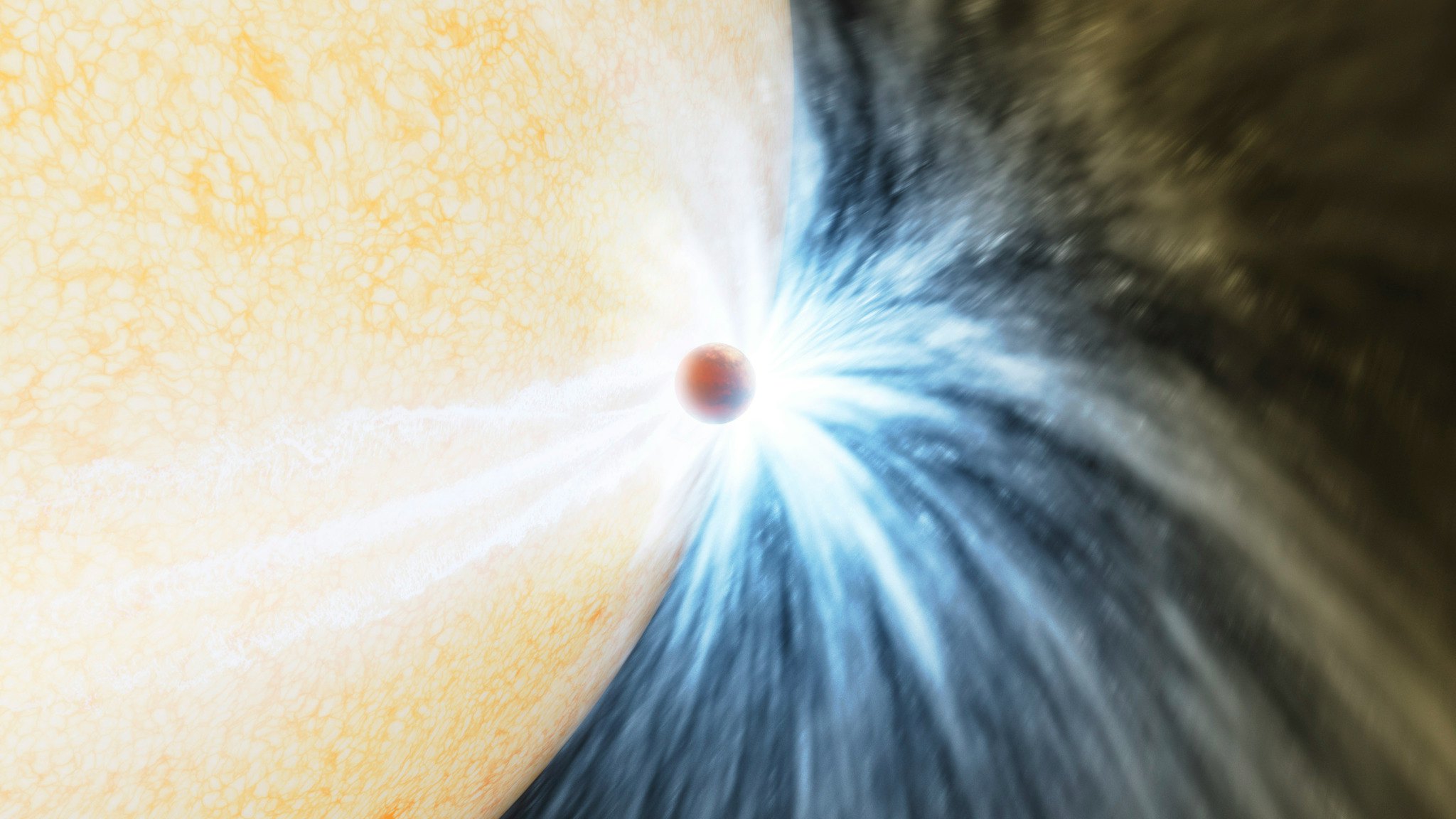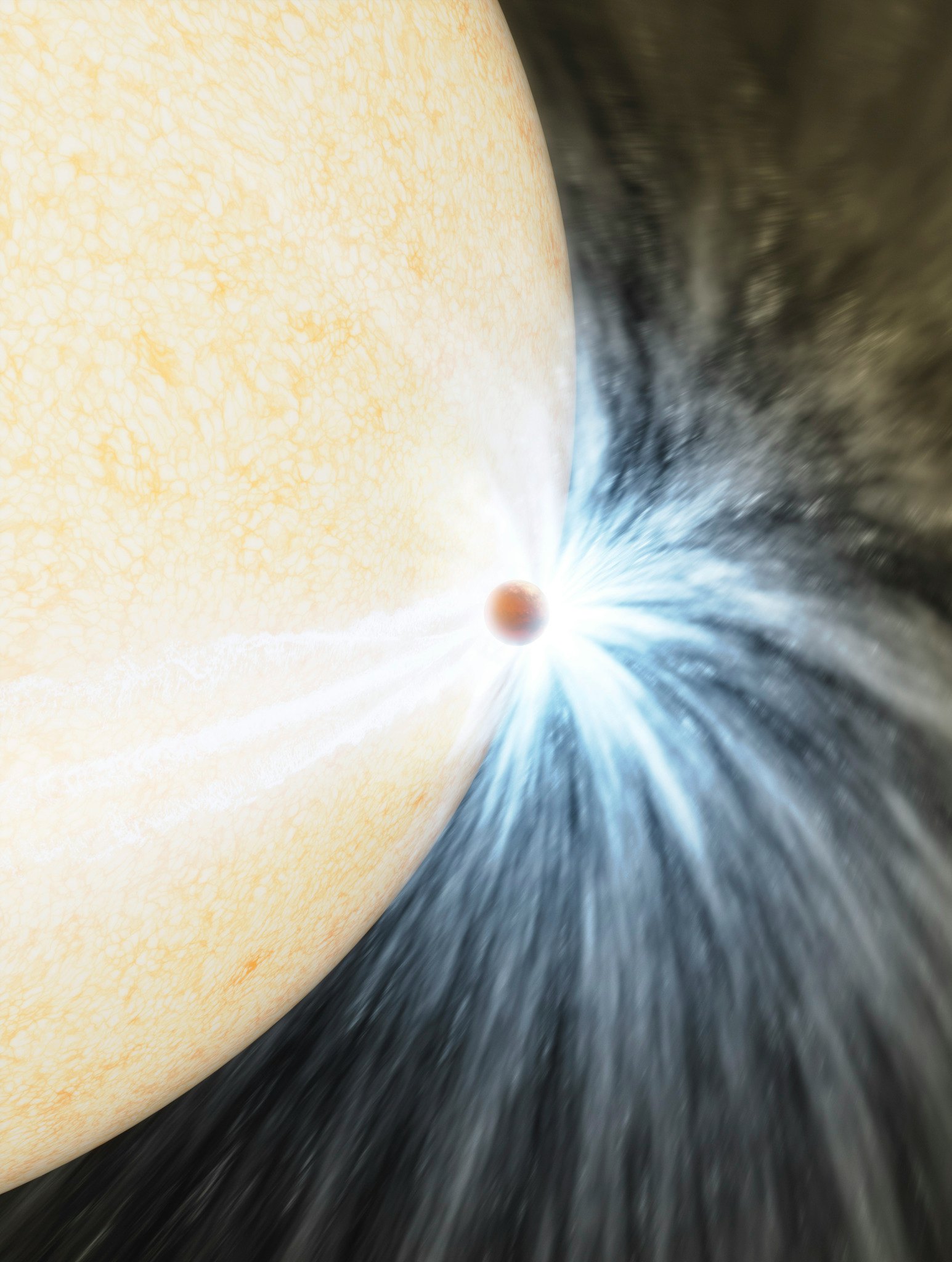
Whether we like it or not, someday, our Sun will swell outward and engulf our planet like a fiery amoeba. That’s the fate of most worlds around middleweight stars, according to physics. And astronomers recently witnessed it for the first time in a star system 12,000 light years away.
They published their findings in the journal Nature.
A Cold Starburst
Like most scientific discoveries, this one started with someone noticing something weird.
The bright flash of light in data from the Zwicky Transient Facility (ZTF) looked like nothing MIT astronomer Kishalay De and his colleagues had ever seen before. Over several nights, a distant star grew more than a hundred times brighter. It took several months for the star’s light to slowly fade to its normal faint glow.
Over several years, De and his colleagues poured over this data and information from three other observatories. Finally, they settled on a theory on what the burst meant: 12,000 light years away, a bloated, dying star had swallowed up a gas giant a few times the mass of Jupiter.
For more than a century, physics models have predicted that this should be the ultimate fate of planets orbiting close to certain smallish stars. In theory, unless a star is about 8 times more massive than our Sun, it won’t die in a supernova. Instead, as it burns up its fuel, a star will get dimmer and swell outward, engulfing anything in its path. But astronomers had never actually seen this happen until now.
“This should happen all the time, but the reason we're catching this red-handed for the first time is that these are hard to find,” says Caltech astronomer Mansi Kasliwal, a co-author on the recent study. “[These mergers] are not very bright. They're wimpy.”
Solving a Cosmic Mystery
Shortly after spotting the strange burst of light in the ZTF data, De looked at the star through the instruments of the Keck Observatory, which split the starlight into the individual wavelengths that made it up. That spectrum of light reveals information about what an object is made of. From this, De surmised that the star he’d seen light up the sky was surrounded by cold gas. This was strange. Typically, the death of an explosive star, otherwise known as a supernova, would heat everything around it. This further puzzled De.
About a year after spotting the burst of light in the ZTF data, De and his colleagues looked at the same star with the infrared cameras on the Palomar Observatory and NASA’s NEOWISE space telescope.
“That infrared data made me fall off my chair,” says De.
“The source was insanely bright in the near-infrared.” It looked as if the cold gas that had surrounded the star in the Keck data had, in the months since, condensed into dust. De and his colleagues realized they weren’t looking at an explosion, they were looking at a cosmic splash. When two stars merge with each other, they give off a bright flare of light, but they also splash huge amounts of gas into space, where it cools and settles into dust.
What De and his colleagues saw, through multiple telescopes, looked a lot like the aftermath of a star merger — a bright burst of visible light and a lingering infrared glow — but it was about a thousand times dimmer than any stellar merger they’d ever seen. For that to happen, one of the objects had to be about a thousand times smaller than a typical star. And that’s when De and his colleagues realized what they were seeing: the death of a planet.

Going Out With a Splash
Until the star entered the final, bloated phase of its life, the planet had probably “existed stably for billions of years, and then all of a sudden it goes wrong in a handful of orbits,” says Harvard-Smithsonian Center for Astrophysics astronomer Morgan MacLeod, also a co-author on the recent study. The planet would have found itself skimming the outer layers of the star’s photosphere, a layer of gas like the outer layers of a planet’s atmosphere but much, much hotter.
The planet kicked up a wake of gas behind it as it skimmed those upper layers of the photosphere, which made the star look brighter in the infrared wavelengths for a few months before the merger. The star’s upper layers also created a drag on the planet, slowing its orbit and causing it to fall inward.
And then it was over. Like a spacecraft re-entering Earth’s atmosphere, the planet “is crashing through the atmosphere of the star, it's heated up, and it's eventually ripped apart,” says MacLeod.
And like a rock being thrown into a pond, the planet splashes a huge plume of material from the star out into space. Gradually, that splashed material cooled to molecular gas and then coalesced into dust surrounding the star, which is what created the bright infrared glow that knocked De out of his chair.
De and his colleagues made follow-up observations a couple of years after the event. The infrared-bright cloud of dust still lingered, but the star had otherwise returned to normal.
“It kind of looks very similar to what it was before the outburst, almost like the star ate that planet and forgot about it completely,” says De.
The Future of Earth
Many of the exoplanets we know of will meet the same fate. They orbit close to their stars, and their stars are larger than a quarter of the Sun’s mass but smaller than the threshold for a supernova. The doomed planets include most of the rocky exoplanets orbiting in the habitable zones of red dwarfs (except the TRAPPIST-1 worlds, because TRAPPIST-1 is too small to end this way), as well as most of the gas giants on scorchingly close orbits around more massive stars.
And, of course, there’s our own little planet. Five billion years from now, the Sun will burn up its internal fuel. It will fade to a dim red and start to balloon outward. It will take tens of thousands of years from the time the Sun swallows up Mercury until it expands far enough to draw in Venus and then Earth. By then, of course, our world will no longer be habitable anyway. The habitable zone will have moved further out in our Solar System, and whoever is there will have a front-row seat to the end of our world.
“One of the big reasons we do astronomy in the first place is to answer two big questions: where we come from and where are we going,” says De. “This is where we are going.”







